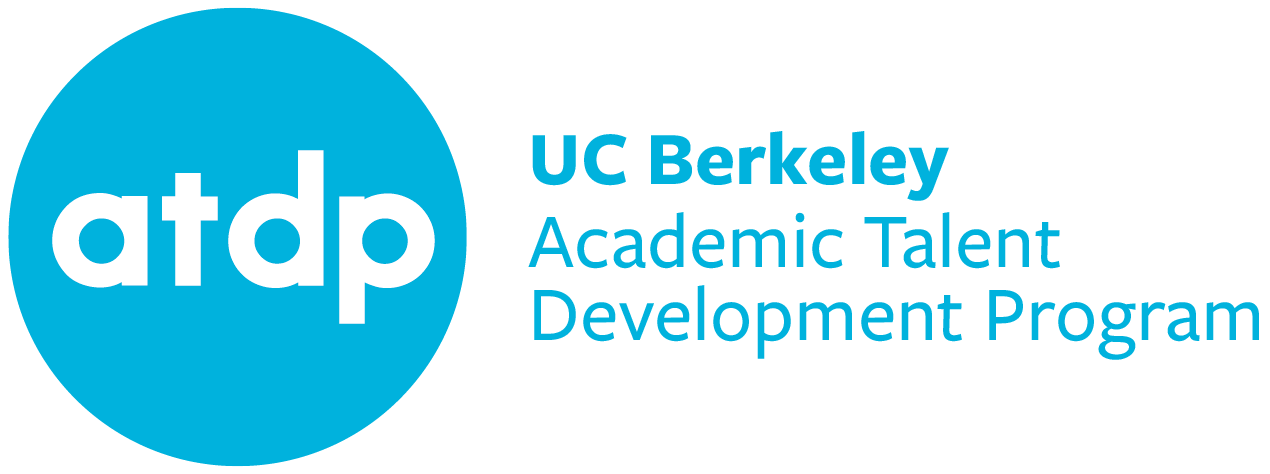Welcome to the ATDP Family E-Newsletter

Dear ATDP students, parents, alumni, and friends,
Welcome to our Summer 2009 e-newsletter. Regardless of whether you are joining us for the first time or are returning to ATDP for the twelfth time, as are a few students, this issue offers new insights into our learning community and useful information about learning.
This time our focus is on the extended ATDP family and is full of news from and about students, alumni, ATDP instructors, and ATDP researchers—one of whom is an alumna, former teacher, current mathematics coordinator, and a doctoral student. In addition to the news items, this issue launches two new features: Research at ATDP, and Not Frequently Enough Asked Questions. We hope that you will enjoy the articles and reports. If you did not receive the previous issue of our Fall 2008 e-newsletter, read it online here.
Cordially, Nina Hersch Gabelko, Director UC Berkeley ATDP |
 Frank C. Worrell, Faculty Director Associate Dean, Grad. School of Education |

RESEARCH AT ATDP
In this issue, we are beginning a new tradition of sharing research findings from studies involving ATDP students. Although this section may be new, ATDP has had a long tradition of involvement in research, in keeping with its role as a division of the premier public research institution in the US and arguably the world. As Dr. Gabelko notes in her introduction to the program brochures, in addition to helping students think and understand more deeply, ATDP is also actively involved in learning more about academically talented students and the factors that facilitate their development.
~ Frank C. Worrell
- “How do Academically Talented Adolescents Think about the Past, the Present, and the Future?”
by Zena Mello - “Predicting Success in ATDP Accelerated Mathematics Courses”
by Adena Young - “Summary of research at ATDP this summer”
by Frank C. Worrell
READING AT ATDP

 In her May 16, 2009 editorial in the New York Times “Some Thoughts on the Lost Art of Reading Aloud,” Verlyn Klinkenborg, referring to the time of Jane Austen, said:
In her May 16, 2009 editorial in the New York Times “Some Thoughts on the Lost Art of Reading Aloud,” Verlyn Klinkenborg, referring to the time of Jane Austen, said:
“In those days, literate families and friends read aloud to each other as a matter of habit. Books were still relatively scarce and expensive, and the routine electronic diversions we take for granted were, of course, nonexistent. If you had grown up listening to adults reading to each other regularly, the thought of all of those solitary 21st-century individuals hearkening to earbuds and car radios would seem isolating. It would also seem as though they were being trained only to listen to books and not to read aloud from them.”
And then, when, on top of that, Nicholas D. Kristof, on July 4, 2009, added his own “Best Kids’ Books Ever,” I knew that I must ask you to visit ATDP’s reading article in our Fall 2008 e-newsletter. We encourage you to submit titles of your favorite books for young people (of all ages) along with your brief annotations. Send them to atdpoffice@berkeley.edu.
NOT FREQUENTLY-ENOUGH ASKED QUESTIONS
As you already know, “frequently asked questions” are posted just about everywhere. These questions are most useful in saving time for applicants as well as for the people at the receiving end of the questions. But think about it for a moment. Questions become “frequently asked” because people know to ask them. If they didn’t know, they couldn’t ask. So, what about those questions that people didn’t know to ask, were too shy to ask, or maybe hadn’t ever thought about? Couldn’t some of those be even more useful than many of the frequently asked questions? For this issue, we asked instructors to ask and answer some questions that they would like to be asked more often. [Continue reading…]
What happens to young students from schools with a 70% drop-out rate who have the opportunity to attend ATDP?
[ Continue reading… ]
FEATURE ARTICLES
ATDP alumni working to make the world a better place…
- “ATDP and the Internet: Four alumni—Four thousand stories”
- “From Berkeley to Watts, and Back Again”
- “World’s Oldest Living Alum Testifies on Behalf of Evolution”
- “Alumna, Engineer, Math Tutor”
TIDBITS

